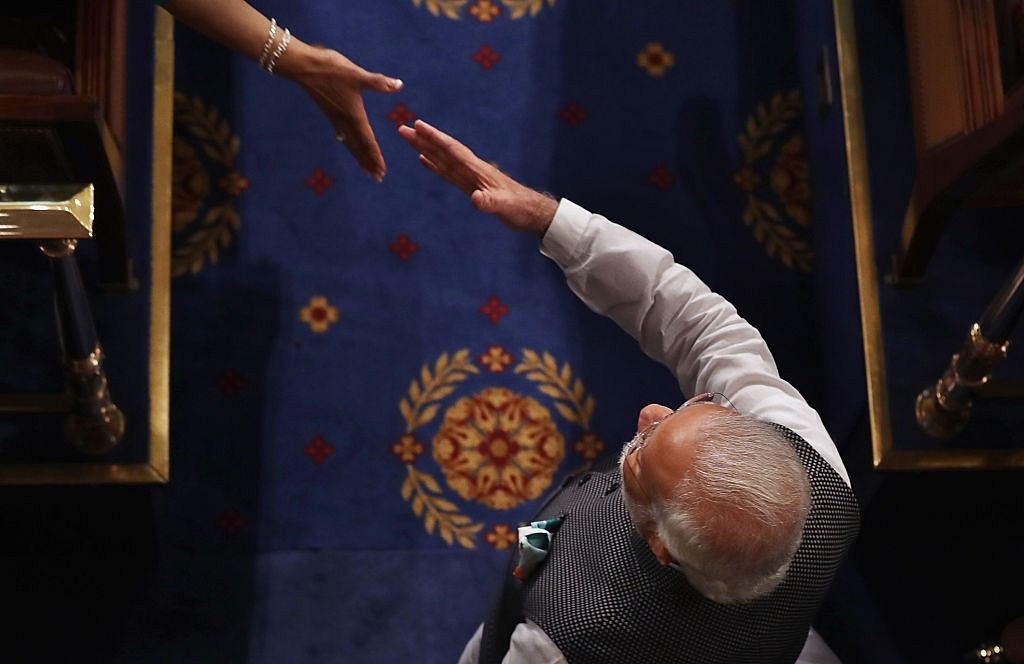Politics
How Narendra Modi Skips Over Traditional Media To Get His Message Out
- Prime Minister Modi will be credited with being the Indian politician who changed ‘social networking’ into ‘social media’. Here’s how.

Prime Minister Narendra Modi. (Chip Somodevilla/Getty Images)
Prime Minister Narendra Modi is an excellent orator and perhaps the best we have – this is fait accompli among his supporters, detractors and everyone in between. Be it delivering rousing speeches at places like Madison Square Garden or fact-filled, stinging rebuttals on the floor of the Parliament, his public speaking has often set the standard for another generation of public speakers, just like Atal Behari Vajpayee’s did earlier.
Recently, External Affairs Minister Sushma Swaraj observed that Modi was not only an orator but an excellent communicator. Indeed, oratory is only one part of the art of messaging.
At ‘Pariksha Par Charcha’, an event where he took questions from students, he kept the not-easy-to-impress millennial audience hooked throughout a 90-minute interaction with alternate doses of wit and wisdom. One of the videos of a youngster asking Modi if he’s prepared for his own exams – the Lok Sabha polls – and Modi’s subsequent answer has already gone viral.
This is the latest in a long list of innovative outreach initiatives adopted by Modi. Taking questions from exam-facing students just as the exam season looms around the corner, easing their nerves by giving them a pep talk is the last thing Indian prime ministers are expected to do but that is exactly what PM Modi has done.
Modi’s penchant for technology and new media, and the vistas they open up, puts him in a different league in contemporary Indian politicians. There were some politicians on social networking sites along with, or even before, Modi. Most of these political leaders simply used it as a personal diary for public consumption where they showed a lighter side of themselves. It was mostly harmless entertainment. However, it was Modi who took ‘social networking’ and made it ‘social media’ – an irreversible shift in politics. While social media still largely means Twitter and Facebook to most, Modi has long diversified into Instagram, LinkedIn and even Weibo! The very medium that was earlier scoffed at by large sections of the political and intellectual elite is a hotbed of political narratives today, largely due to Modi.
If everyone is doing social media, then shouldn’t Modi do something else that veers into uncharted territory?
He is possibly the first Indian politician to have a mobile application of his own. This application too, does not merely tick some boxes, but contains everything from live-streaming of his speeches to neatly labelled archive videos, from op-eds by eminences to the latest media coverage.
His ‘Pariksha Par Charcha’ event with students is reminiscent of another famous messaging innovation. Chai Pe Charcha, the campaign that was conceived to convert a slight by Mani Shankar Aiyar into a messaging victory for Modi was a success, not just for its innovative packaging but also because it struck the right chord with the aspirational class that stood for self-reliance and socio-economic mobility.
After becoming Prime Minister, another communication coup that he has consistently pulled off is in foreign lands. Be it Madison Square Garden or Sydney, Netherlands, or West Asia, his specific outreach programmes with the Indian diaspora abroad have certainly been helpful in building Brand Modi. But it would be unfair to restrict them to just that. The sheer scale of the events and the wide reporting around them have served as shows of India’s strength abroad and also filled the Indian diaspora with the feeling that they are valued by the government back home.
So far, we have spoken purely of external communication. Internally too, within his party, Modi has a messaging module on his own application. This messaging module, which was recently reported about in the media too, is open to party functionaries as a collaboration platform. The power of such a platform is immense, especially because the Bharatiya Janata Party is a cadre-based party.
In just the last week or so, on the one hand, Narendra Modi interacted with beneficiaries of the Ujjwala programme, which has been a massive success in providing free LPG connections to poor households, while on the other hand, he engaged exam-facing school children who form a vastly different part of the societal spectrum.
Despite the din on mainstream and social media, with sections of the media and the Opposition – sometimes the two are indiscernible – clearly trying to push their pet agendas, Narendra Modi is doing his own thing by not being stuck in reaction mode, but reaching out to sections of society that were hitherto unreached.
Introducing ElectionsHQ + 50 Ground Reports Project
The 2024 elections might seem easy to guess, but there are some important questions that shouldn't be missed.
Do freebies still sway voters? Do people prioritise infrastructure when voting? How will Punjab vote?
The answers to these questions provide great insights into where we, as a country, are headed in the years to come.
Swarajya is starting a project with an aim to do 50 solid ground stories and a smart commentary service on WhatsApp, a one-of-a-kind. We'd love your support during this election season.
Click below to contribute.
Latest